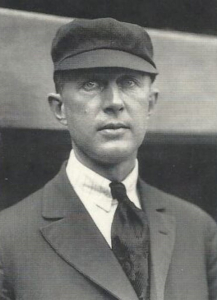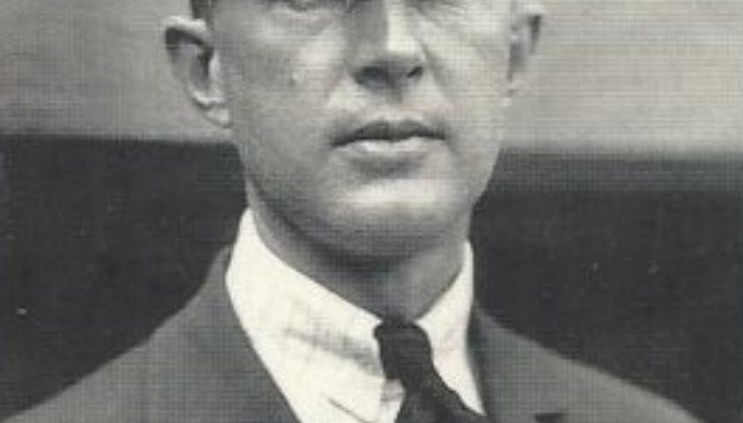September 2, 1912: Reds and Cardinals can’t see in the dark, but umpire Mal Eason says, ‘Play on’
 Before the arrival of stadium lights, an umpire decided when a game must be halted due to darkness. How dark is too dark to play? It was not an easy decision.
Before the arrival of stadium lights, an umpire decided when a game must be halted due to darkness. How dark is too dark to play? It was not an easy decision.
On Labor Day, Monday, September 2, 1912, the Cincinnati Reds and St. Louis Cardinals played a doubleheader at Cincinnati’s new Redland Field. The first game was won by the Reds, 5-2. It began at 1:30 P.M. and finished at 3:32 P.M. The start time of the second game was not reported, only that the game commenced “after a short rest.”1 Play probably started before 4:00 P.M. Sunset was at 6:35 P.M.2 It fell to Mal Eason, the home-plate umpire in the second game, to decide when it became too dark to play.
For the 33-year-old Eason, a former pitcher who had appeared in 125 games for four big-league teams, this was his 364th game as a major-league umpire. He was paired with Jim Johnstone, a 39-year-old umpire with more than 1,500 games of major-league experience. Johnstone worked behind home plate in the first game of the doubleheader while Eason watched the bases. They switched places for the second game.
Hank O’Day had worked more than 2,000 games as a major-league umpire before becoming the Reds manager in 1912. He was known for his integrity and for never losing his cool.3 The Cardinals were managed by a famous catcher, Roger Bresnahan, a “fiery Irishman.”4 The Reds were in fifth place and the Cardinals in sixth place in the National League standings.
In the second game of the doubleheader, both starting pitchers were rookies making their second major-league start: Frank Harter for the Reds and Dan Griner for the Cardinals. These right-handers were recently promoted from Class D minor leagues, Harter from Portsmouth in the Ohio State League and Griner from Cleveland, Tennessee, in the Appalachian League.
It was a sweltering day, 100 degrees at the start of the first game and 94 at the start of the second.5 It was “much too hot to play ball,” said the St. Louis Globe-Democrat.6 Nonetheless, “about 9,000” fans came to the ballpark, “a big crowd for such a hot day.”7 Surely, the lemonade vendors did brisk business.
Miller Huggins, the Cardinals’ 34-year-old second baseman, led off the second game with a single to center field. Lee Magee followed with a single to right that sent Huggins to third base. Mike Mowrey flied out to center field, and Huggins tagged up and scored.
Harter seemed to lose his composure; he walked the next two batters, Ed Konetchy and Steve Evans, to load the bases. But those were the only walks he allowed in the game. He got out of the jam when Arnold Hauser fouled out and Rebel Oakes grounded out. Harter settled down and retired the Cardinals in order for the next five innings.
The Reds got to Griner for a run in the second inning, another in the third, and two more in the fifth. They were greatly helped by the struggles of Steve Evans in right field. In the second inning, Eddie Grant lifted a high fly to right. Evans lost it in the sun; he did not have “the slightest idea as to where the ball was hit until it dropped on the ground.”8 Grant was credited with a triple, and he came home on Dick Egan’s single to center field.
In the third inning, the Reds’ Armando Marsans reached on a fielder’s choice, stole second (his 33rd stolen base of the season), and moved to third on an infield out. A single by Mike Mitchell brought him home.
Cincinnati’s Bob Bescher tripled to right field in the fifth inning. This was another one that should have been caught by Evans, said the Globe-Democrat. Marsans doubled to left field, scoring Bescher. Evans’ woes continued when Dick Hoblitzell sent a high fly to right field. Evans lost it, too, in the sun. Marsans scored and Hoblitzell was credited with a double. A furious Bresnahan immediately benched Evans and replaced him with Rube Ellis.
The Reds led 4-1 after six innings. With one out in the top of the seventh, Hauser reached on a grounder to Grant, the shortstop, who threw poorly to first for an error. Oakes singled up the middle. Bresnahan drove the ball to the fence in left field for a double that scored Hauser and Oakes. Pitcher Bob Harmon ran for Bresnahan and represented the potential tying run.
Ivey Wingo, a left-handed batter, stepped to the plate to pinch-hit for Griner. O’Day replaced pitcher Harter with Gene Moore, a southpaw. Bresnahan countered by calling Wingo back to the bench and putting in Wally Smith, a right-handed batter. Smith’s short fly to center field was caught by Marsans. The ball was tossed to one of the middle infielders, shortstop Grant or second baseman Egan. Moments later, Harmon was caught off second base by the hidden-ball trick. One can imagine the scolding he received from Bresnahan.
Bescher singled off right-hander Sandy Burk to start the bottom of the seventh and promptly swiped second base; it was his league-leading 54th stolen base of the season. Burk walked Marsans and Hoblitzell to load the bases. Mitchell grounded into a 6-4-3 double play, and Bescher scored on the play. With the Reds leading 5-3 after seven innings, Bescher and his Cincinnati teammates begged Eason to call the game on account of darkness. Bescher “was told to go to his place in left field.”9
Play continued in the top of the eighth inning with the Cardinals at bat and Bescher hollering from left field that he could not see the ball. Meanwhile, the fans “sprung some new comedy by setting fire to their score cards and holding the blazing paper up in the air.”10
Huggins drew a walk from Moore to start the inning. Magee singled to center field, sending Huggins to third base, and Magee stole second. Mowrey walked to load the bases. The runners moved up a base on Konetchy’s infield out, with Huggins scoring. Ellis grounded to Grant, who threw Magee out at the plate. Ellis bluffed a steal of second base, and catcher Tommy Clarke bluffed a throw there. Clarke then fired the ball to Art Phelan at third base, and Mowrey, “caught flat-footed,” was tagged out.11 More scolding from Bresnahan surely followed.
At this point, “it was getting very dark,” wrote Jack Ryder of the Cincinnati Enquirer, and “it was perfect folly to continue the game.”12 Mitchell, the Reds captain, requested that the game be called, but Eason ignored his plea and the game continued.
Playing in darkness, the Reds did not score in the bottom of the eighth. The Cardinals came to bat in the top of the ninth, trailing by a run and unable to see the ball. The first batter, Hauser, struck out. “The fans were by this time lighting bonfires of paper all over the stands, and some rushed out on the field and started illuminations.”13
It was a frightening moment when the next batter, Oakes, was hit by a pitch. The Reds “came rushing in from all directions to insist that the farce be stopped at once.”14 Bescher ran in from left field in a rage and had to be restrained by his teammates “to prevent a serious altercation.”15
“Order was finally restored and the game went on.”16 The next two batters were pinch-hitters: Bill Steele grounded out to Egan, and John Kelleher struck out. The game was over; the final score was Cincinnati 5, St. Louis 4. The time of the game was reported to be 2 hours and 17 minutes. The game ended in “pitch blackness, illumined only by thousands of extemporized torches waved about the dark arena.”17
As Eason left the field, the Reds, led by Bescher, rushed toward him in anger. O’Day, recognizing the danger of the situation, put his arm around Eason’s shoulder and escorted him to the umpires’ dressing room.
O’Day, the wise old umpire, was interviewed after the game. “I can’t understand what got into Eason,” he said. “He wouldn’t even go and consult with Umpire Johnstone, although anyone could see it was utterly dark, and no sense in keeping on. A game should be called before darkness, not after darkness has set in. I hate to criticize an umpire, but this was bull-headedness beyond belief.”18
No explanation from Eason was found in newspaper accounts of the game. He umpired in the National League for four more seasons, 1913-16.
Acknowledgments
The author thanks Charlie Bevis for information about doubleheaders circa 1912. The article was fact-checked by Kevin Larkin and copy-edited by Len Levin.
Sources
In addition to the sources cited in the Notes, the author consulted Baseball-Reference.com and Retrosheet.org for pertinent information, including the box score. He also reviewed game coverage in the September 3, 1912, issues of the Cincinnati Enquirer and St. Louis Globe-Democrat.
https://www.baseball-reference.com/boxes/CIN/CIN191209022.shtml
https://www.retrosheet.org/boxesetc/1912/B09022CIN1912.htm
Notes
1 “Double Defeat for Bresnahan’s Cohort,” St. Louis Globe-Democrat, September 3, 1912: 10.
2 “Weather Forecast,” Cincinnati Enquirer, September 2, 1912: 6. This was before Daylight Saving Time, which began in 1918.
3 Dennis Bingham, “Hank O’Day,” SABR BioProject.
4 Joan M. Thomas, “Roger Bresnahan,” SABR BioProject.
5 “Four Die from Terrific Heat,” Cincinnati Enquirer, September 3, 1912: 14.
6 “Double Defeat for Bresnahan’s Cohort.”
7 “Double-header Briefs,” Cincinnati Enquirer, September 3, 1912: 8.
8 “Double Defeat for Bresnahan’s Cohort.”
9 “Double Defeat for Bresnahan’s Cohort.”
10 “Double Defeat for Bresnahan’s Cohort.”
11 “Double Defeat for Bresnahan’s Cohort.”
12 Jack Ryder, “Reds Celebrate Labor Day by Taking Two Games from St. Louis Cardinals,” Cincinnati Enquirer, September 3, 1912: 8.
13 Ryder, “Reds Celebrate Labor Day by Taking Two Games from St. Louis Cardinals.”
14 Ryder, “Reds Celebrate Labor Day by Taking Two Games from St. Louis Cardinals.”
15 Ryder, “Reds Celebrate Labor Day by Taking Two Games from St. Louis Cardinals.”
16 Ryder, “Reds Celebrate Labor Day by Taking Two Games from St. Louis Cardinals.”
17 W.A. Phelan, Cincinnati Times-Star, reprinted in: “How Mal Eason Had Game Finished by Fans’ Torchlights,” Chattanooga Times, September 8, 1912: 3-8.
18 Phelan, Cincinnati Times-Star.
Additional Stats
Cincinnati Reds 5
St. Louis Cardinals 4
Game 2, DH
Redlands Field
Cincinnati, OH
Box Score + PBP:
Corrections? Additions?
If you can help us improve this game story, contact us.


